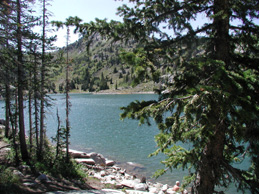Salt Lake City Adopts Watershed Master Plan
City Council updates 1988 Plan.
September 13, 1999
|
On July 6, 1999, the City Council held its last public hearing on the plan. Issues raised at the hearing included, 1) use of herbicides and pesticides within the canyon, 2) snowmaking additives, 3) additional restrooms, 4) land trade between the City and U.S. Forest Service, 5) potential gates at the entrances of Big and Little Cottonwood Canyons, 6) erosion, and 7) additional input from canyon residents. Concerns raised by the State Division of Natural Resources regarding fishing were resolved before the hearing. One speaker indicted that the City was claiming that Mill Creek water quality had improved since the fee gate was established. It was clarified that the canyon had improved, but the water quality had not substantially changed.
The final plan recommends that an ordinance be developed to govern herbicides and pesticides within the watershed canyons. In order to develop the necessary technical information, an interdisciplinary team from the state, UDOT, Salt Lake County, Utah State Extension Services, U.S. Forest Service, Salt Lake City and a representative from the private sector were impaneled during July to begin the process of developing an ordinance by March 2000.
An independent study of snowmaking additives will be required, funded by the manufacturer. Additives will be allowed on a limited and controlled basis for 3 years.
Public Utilities will immediately form partnerships to improve communications regarding issues affecting others in the canyons, including the Big Cottonwood Community Council.
The Plan calls for increased efforts to purchase watershed property and an additional $0.25 was added to each water bill to increase the “Watershed and Water Rights Purchase Fund.”
Another major effort will focus on public education. A public awareness campaign will highlight the importance of the watershed and why it needs to be managed and used with care.
Russ Hone, Watershed Administrator, is concerned about the future of the watersheds. “The Wasatch-Cache forest is the highest used forest in the United States and the use is continuing to grow, as the Wasatch Front grows,” he says. Hone supports multiple use of the canyons, in which the U.S. Forest Service is the major land owner, but he is concerned with the long term effects of more people in the canyons. “Each user feels that their individual actions alone will not damage the environs, but it’s the accumulative effect of thousands upon thousands that concerns me,” he continues. During his career, he has seen first hand the explosive increases in recreational use within the watersheds. “The sewers in both Big and Little Cottonwood Canyons have help keep pollution levels down in the streams. On the other hand during the past several years, sewer line overflows have discharged into the streams, making it necessary to shutdown the water treatment plants on 4 different occasions while the sewage was contained and cleaned up. This is a growing concern,” says Hone. Moreover, Hone cites continued growth in the canyons as a major issue. He notes, “The family summer cabin is being replaced with urban style year round homes with all the amenities.” He concludes, “The Master Plan will provide us guidelines in meeting all of the challenges well into the new Millennium.”
One of the major initiatives is the formation of a national panel of experts and educators to study the canyon watersheds. All sides involved in the Master Planning process agreed that additional data are needed for future decisions. The Wasatch Canyons are unique and additional studies are needed to measure the impact of increased uses within the watershed area.
Florence Reynolds, Public Utilities Water Quality and Treatment Administrator, wonders
if coliform bacteria is the best pollution indictor. Although this indicator has been used for many years, she isn’t sure that it is the only indicator of pollution in the canyons. In recent years, Giardia and Cryptosporidium sampling have been added to the microbiological testing protocol. She is hoping that the scientific community can come up with new pollution indicators that will help determine deterioration of the watershed that would lead to impaired water quality. “I hope to involve the state’s universities in the study of the canyon watersheds, says Reynolds,” I believe that having the institutions of higher education involved at the local level will enhance our long term understanding of this invaluable resource.” Reynolds plans to enlist the services of nationally known watershed experts from academia, the scientific community and regulatory agencies to help develop a comprehensive study work plan.
Reynolds expressed her appreciation to the Salt Lake City Planning Commission and its staff, the Salt Lake City Public Utilities Advisory Committee, other jurisdiction partners who helped in the planning process, including the Salt Lake County Planning, City County Health Department, town of Alta, U.S. Forest Service and the public who provided their time and input into the Plan.
Questions regarding the ’99 Salt Lake City Canyon Management Plan can be directed to: florence.reynolds@ci.slc.ut.us
